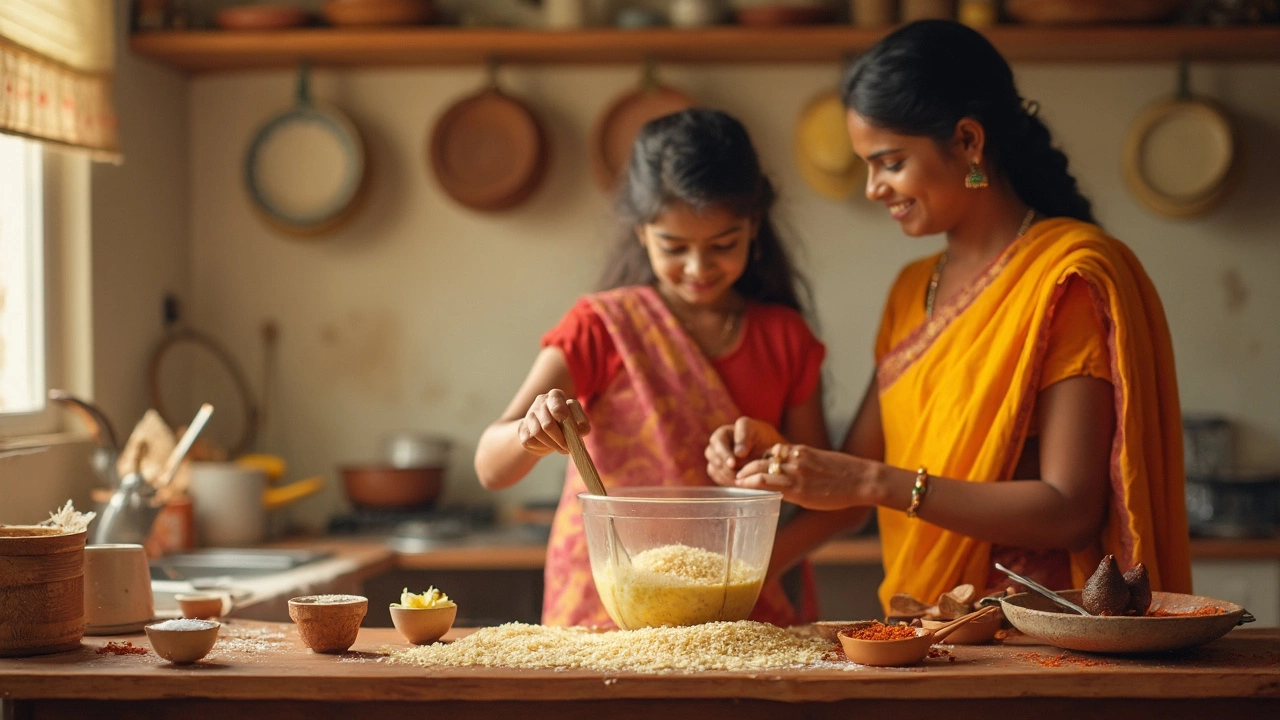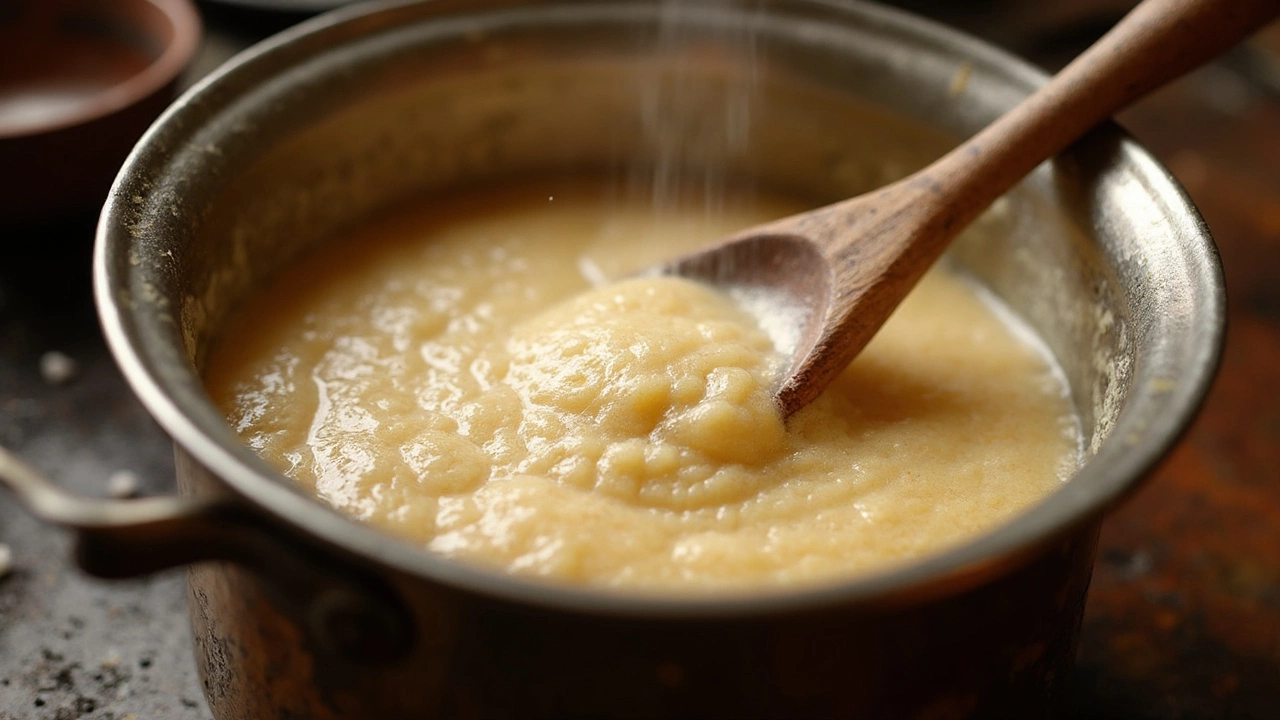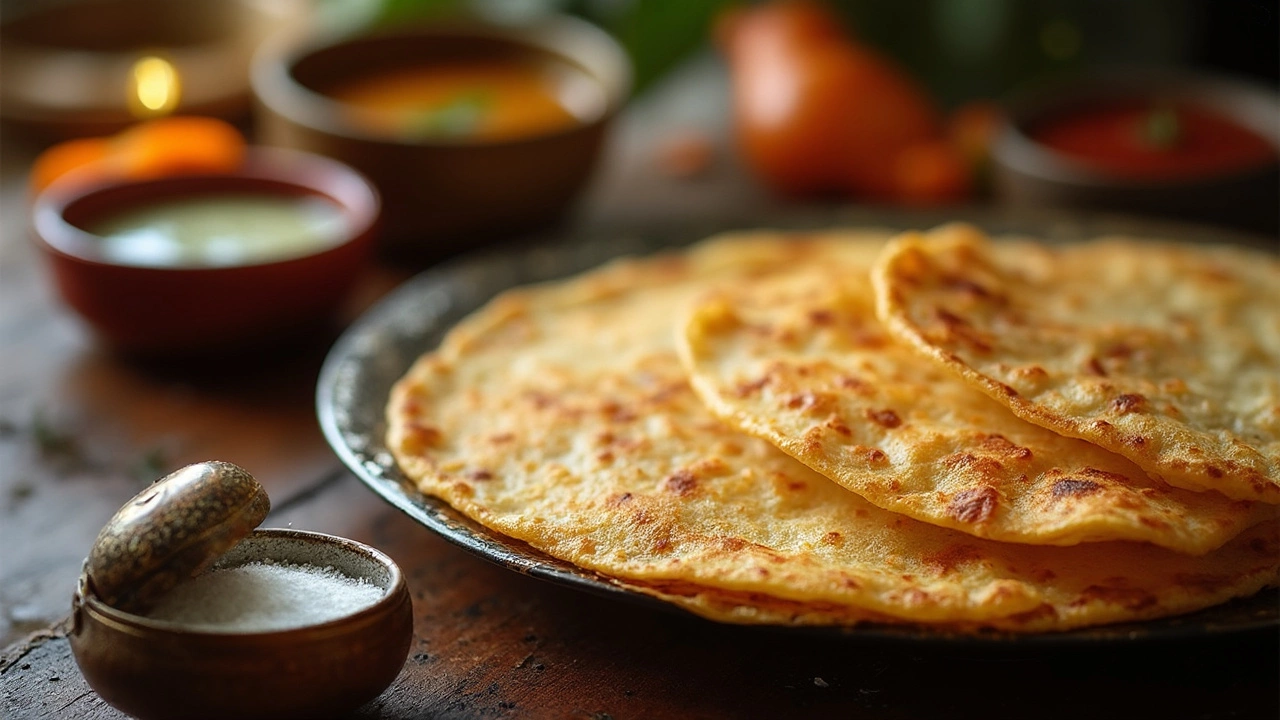Should Salt Be Added Before Fermenting Dosa Batter?
 Apr, 9 2025
Apr, 9 2025
Making dosa is like a mini science project in your kitchen. And one of the big debates? When to add salt. You might have heard different takes—some folks swear by adding it before fermenting, others insist on mixing it in later. So why all the fuss?
When you toss salt into your batter before fermentation, it can slow down the yeast and bacteria a bit. That might sound scary, but it can actually help control how sour your batter gets. On the flip side, waiting until after can mean a more bubbly ferment. But, those bubbles come at a risk of turning your dosa a bit too tangy if you aren't watching closely.
Getting to know the role salt plays can help you get your dosa game on point. So whether you're a kitchen newbie or a seasoned dosa maker, understanding this could be your golden ticket to perfecting your recipe.
- The Role of Salt in Fermentation
- Pros and Cons of Adding Salt Before Fermenting
- Impact of Salt on Dosa Texture
- Tips for Perfect Dosa Batter Fermentation
- Common Mistakes and How to Fix Them
The Role of Salt in Fermentation
Salt is like that quiet helper in your kitchen, doing more than we give it credit for. When it comes to dosa batter, its timing is everything. You might think salt is just for taste, but it plays a bigger part. It acts like a bouncer for yeast and bacteria—keeping them in check.
So, how does it really work? Salt slows down the yeast and bacteria's party in your dosa batter. Imagine it hitting the pause button so your batter doesn't get overly aggressive in rising and souring. This magic power means your batter can ferment just right, with fewer chances of turning overly tangy.
But, hey, it's not that straightforward. If you add salt from the get-go, you might find your batter rises slowly. This can be a lifesaver in warm climates where stuff ferments like a science experiment gone wild.
On the flip side, skipping salt until after fermentation can lead to a fluffier batter with more bubbles. Great for those soft and crispy dosas, but if it's too tangy for your taste—yikes. Plus, depending on where you live, you might not want your dosa tasting like a sour bomb.
So what's the verdict? Adding salt before or after is less about right or wrong, and more about the end result you crave. Some dosa enthusiasts swear by pre-salting because it helps control fermentation, so the batter turns out consistently well.
Pros and Cons of Adding Salt Before Fermenting
Alright, so you're at the crossroads of adding salt to your dosa batter before that whole fermentation shindig kicks off. It's like picking sides in a friendly food feud. Let's break down what you’re in for either way.
Pros:
- Flavor Control: Adding salt early can help you keep a lid on the tartness. This can be a lifesaver if you're not into the super-sour vibe.
- Consistency: Salt does wonders for achieving a uniform consistency. It can help thicken the batter, which makes for a sturdier base.
- Fermentation Speed: Believe it or not, salt can slow down the fermentation process a tad. If you're in a sweltering climate where batters ferment at lightning speed, this can be a blessing.
Cons:
- Slowed Fermentation: While controlling speed can be good, it might also mean a less airy batter. If you're aiming for those crispy, lace-thin dosas, this could be a hurdle.
- Saltiness: If you mess up the quantity, you might end up with an overly salty batter, especially after prolonged fermentation when the flavors intensify.
- Uniformity Issues: Adding salt before often risks uneven distribution in thicker batters. You might find some patches saltier than others.
At the end of the day, it boils down to preference. Are you a bold flavor adventurer, or do you like your dosas mild and mellow? Understanding these pros and cons can help you make that call and elevate your homemade dosa game.

Impact of Salt on Dosa Texture
If you've ever wondered why your dosa batter sometimes turns out differently, salt might be the culprit. The timing of when you add salt can genuinely affect the texture of your final dosa.
Adding salt before the fermentation of your dosa batter can result in a slightly denser texture. This happens because salt can influence the growth of yeast and bacteria, the very little organisms that make your batter rise and get airy. By slowing these down a notch, your batter ends up fermenting more evenly, potentially giving you flatter dosas. They may not be super crispy, but they sure hold together nicely.
On the other hand, mixing salt in after fermentation might lead you to irresistibly crispy dosas. Without salt meddling in the early stages, the yeast and bacteria go wild, creating tons of bubbles. Those bubbles? They're what makes your dosa light, crispy, and almost melt-in-your-mouth.
An interesting fact to consider is how temperature and humidity can play into this whole process. For instance, if you're in a warmer climate, even with salt, the batter might ferment faster and still develop a lovely texture. So playing around with when you add salt can also be kind of an experiment based on where you live.
No matter which method you choose, knowing how salt impacts texture gives you more control over your dosa-making adventure. You can adapt based on what kind of dosa you're in the mood for or the environment you're working in. It’s like becoming the dosa master of your own kitchen!
Tips for Perfect Dosa Batter Fermentation
Nailing the fermentation process for your dosa batter can sometimes feel like chasing a moving target. But with the right tricks up your sleeve, you can hit that sweet spot every time. Here’s how you can master it.
First off, temperature is your batter's best friend. It's gotta be just right. If you're in a warm area, let it sit in a cozy corner. If it's too chilly, maybe consider setting the batter in your oven with just the light on—it's a neat little hack that often works wonders.
Speaking of timing, patience is key. Give your batter a good 8 to 12 hours to ferment. Some folks like to do it overnight while they catch some Zs. You'll know it's ready when you see that lovely layer of bubbles on top.
When it comes to equipment, keep it simple but effective. Make sure the container you're using is deep and roomy. Fermentation makes your batter rise, and using a shallow bowl could lead to messy overflows. And always use clean tools! No need to invite unwanted guests (aka bacteria) to the party.
If using fresh rice and lentils, dry them off well after washing. Extra water can mess with the consistency.
Finally, if you’re adding salt in batter before fermenting, go easy on it. A little can go a long way in keeping that tanginess balanced.
Remember, practice makes perfect. If your first batch doesn’t turn out quite right, adjust and try again. Once you get the hang of it, you’ll wonder why you ever worried in the first place!

Common Mistakes and How to Fix Them
Let’s keep it real: fermenting dosa batter can sometimes feel like trying to solve a mystery. Here are common goofs folks make and how to dodge them:
- Batter Too Watery: A watery batter can turn your dosa into a soggy mess. If you see this happening, try adding a bit of rice flour to thicken it up. It helps maintain the right texture for the perfect crisp dosa.
- Batter Didn't Rise: Fermentation is the magic word here. If your batter didn’t rise, check if your kitchen was cold. In colder temperatures, putting the batter in a warm place or using a warm oven (switched off) for a few hours can kickstart the fermenting process.
- Too Sour Taste: Left your dosa batter to ferment too long? That can make it too tangy. Next time, try storing it in the fridge once it ferments well or split the batter and add a pinch of sugar to balance the taste.
- Not Enough Fermentation: Lacking those lovely bubbles? Ensure your dal and rice were soaked and ground properly. Sometimes over-washing your rice removes too much of the natural microbes that help fermentation. Some folks also add a tablespoon of previously fermented batter to jumpstart the process.
- Gummy Dosa: Ever felt like your dosa is more like a pancake? That's likely due to an under-fermented dosa batter or over-cooking it. Fix this with proper fermentation and cook on medium heat to get that crispy edge.
By keeping these tips in mind, you'll nail your dosa batter, turning it into those delicious crisp pancakes you're after. Everybody makes mistakes, but knowing what went wrong and how to fix it can easily turn you into a dosa pro!
